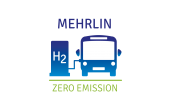The contracts have been signed and sealed: moBiel has now ordered four hydrogen buses and a refuelling station for loading the vehicles. After long preparatory work, the Bielefeld transport company has thus taken an essential step towards its goal of testing hydrogen technology in local transport. The buses are expected to roll over Bielefeld's streets at the turn of the year 2021/22. It was agreed not to disclose the purchase prices.
The four 12-metre buses that moBiel will test on line 29 (Baderbach - Schildhof) come from the Portuguese manufacturer Caetano. The hydrogen refuelling station is supplied by Framatome from Erlangen, a subsidiary of the French Framatome group. moBiel is building the refuelling station on the waste incineration plant site in Bielefeld-Heepen, where the buses will also be stationed.
moBiel Managing Director Martin Uekmann is relieved to have placed the orders: "When our Supervisory Board decided in autumn 2018 to start testing the zero-emission hydrogen technology in operation, we knew that we would not be dealing with an established mass product but with highly innovative technology. Our foresight has been confirmed. It took intensive work and a great deal of patience to clear all the questions relating to funding, Europe-wide tendering, and the award of contracts. But now we have reached the important milestone of the order", he said, adding that moBiel had found the vehicles and a refuelling station in a very tight market that fitted in well with the company's pilot project.
The project is worth millions, adds Kai-Uwe Steinbrecher, moBiel's head of technology. This will be subsidised to 90 per cent for the petrol station and 60 per cent for the buses. The basis for the calculation of the latter is the difference to the price of an equivalent diesel bus. And he emphasises: "It is only thanks to the funding from the State of NRW that moBiel can procure the hydrogen buses and the refuelling station. Because they cannot yet be operated economically. The fuel costs of the four fuel cell buses are also around 60,000 euros higher per year than those of diesel buses.

Buses with a long-range and high driving comfort
Caetano is supplying four 12-metre H2 City Gold buses to moBiel. These have only been on the market in Germany since this year and are being tested in Northern Germany. The buses have Toyota fuel cells on their roof. The five hydrogen tanks, also located on the roof, can hold 37.5 kilograms of hydrogen. According to the manufacturer, this is sufficient for a range of around 350 to 400 kilometres. moBiel project manager Gerhard Sawatzky: "The test run will show exactly where we will end up. In any case, the range is roughly equivalent to what our buses must manage during the day. This is a great advantage over battery-electric buses. This is because the four buses can be in operation all day on the 7.6-kilometre-long Line 29 without having to refuel in between. Sawatzky: "This means they fit in well with our operational processes."
In the fuel cell of the buses, hydrogen reacts with oxygen and thus permanently generates electrical energy during the journey. This energy is stored in the battery on the vehicle roof or directly drives the 245 HP electric motor. No harmful exhaust gases are produced in the process, only water vapour. moBiel Managing Director Uekmann: "If the buses pass the practical test and become affordable, they could make a major contribution to emission-free bus operation and thus better air in Bielefeld".
Not much will change for the passengers of the hydrogen buses. Because the battery can be much smaller than in a battery-electric bus and a large part of the technology is accommodated on the roof of the vehicle, the passenger compartment will offer as much space as in diesel buses. The 2-door buses will have 37 seats and, as low-floor buses, will be low-barrier. Residents living along the route of line 29 should also be pleased because hydrogen buses will travel almost silently.
Hydrogen refuelling station in Heepen
The refuelling station necessary for the operation of the hydrogen buses will be built on the MVA site. A small storage hall for the buses is also planned there. "We can now enter the implementation phase and will promptly enter into the detailed planning and approval procedures with the responsible authorities," says Kai-Uwe Steinbrecher, pointing the way forward. At around 6,600 m², the entire facility, including paths, storage hall, tanks, and refuelling equipment, take up slightly less space than a football field. The refuelling station will operate with a pressure of 350 bar. For passenger cars, 700 bar would be necessary for comparison. When refuelling, Steinbrecher points out another vital advantage of fuel cell technology: "A charging process will only take about ten minutes. That is much faster than with battery-electric buses".
The plant's tanks are designed for 1,000 kilograms of hydrogen and are initially supplied by tanker trucks. Uekmann and Steinbrecher also envisage producing hydrogen from the electricity generated by waste incineration. That is why the location at the waste incineration plant was chosen for the pilot project: "With the electricity generated in the waste incineration plant, we could produce green hydrogen for our buses and perhaps also other commercial vehicles in the future. This would be an important contribution to the sector coupling aimed at in the context of the energy and transport turnaround. After all, hydrogen is well suited for linking electricity and heat supply, but also transport, and for operating them as efficiently and with low emissions as possible". However, this would only be feasible for the Stadtwerke Bielefeld group of companies if subsidies were available. The technology is still far from being economically viable.







